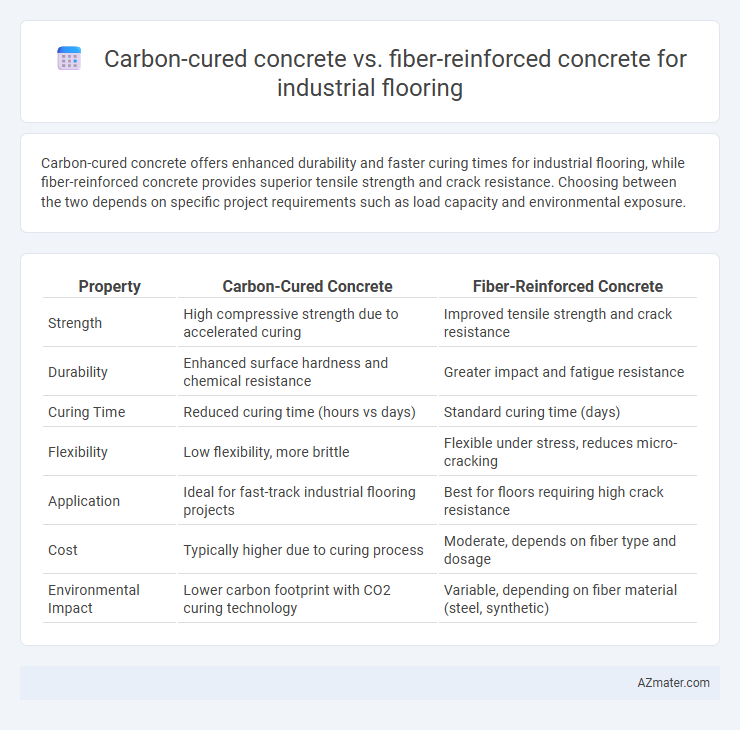Carbon-cured concrete offers enhanced durability and faster curing times for industrial flooring, while fiber-reinforced concrete provides superior tensile strength and crack resistance. Choosing between the two depends on specific project requirements such as load capacity and environmental exposure.
Table of Comparison
| Property | Carbon-Cured Concrete | Fiber-Reinforced Concrete |
|---|---|---|
| Strength | High compressive strength due to accelerated curing | Improved tensile strength and crack resistance |
| Durability | Enhanced surface hardness and chemical resistance | Greater impact and fatigue resistance |
| Curing Time | Reduced curing time (hours vs days) | Standard curing time (days) |
| Flexibility | Low flexibility, more brittle | Flexible under stress, reduces micro-cracking |
| Application | Ideal for fast-track industrial flooring projects | Best for floors requiring high crack resistance |
| Cost | Typically higher due to curing process | Moderate, depends on fiber type and dosage |
| Environmental Impact | Lower carbon footprint with CO2 curing technology | Variable, depending on fiber material (steel, synthetic) |
Introduction to Industrial Flooring Solutions
Carbon-cured concrete offers enhanced durability and reduced curing time by utilizing CO2 injection, making it ideal for industrial flooring requiring rapid installation and sustainability. Fiber-reinforced concrete incorporates synthetic or steel fibers to improve tensile strength and crack resistance, ensuring long-lasting performance under heavy industrial traffic. Both solutions provide advanced mechanical properties tailored for demanding industrial environments, optimizing floor longevity and maintenance.
Overview of Carbon-Cured Concrete
Carbon-cured concrete utilizes injected carbon dioxide during the curing process to enhance strength and durability, making it highly resistant to cracking and wear in industrial flooring applications. This method significantly reduces carbon emissions by permanently sequestering CO2 within the concrete matrix, contributing to sustainable construction practices. Compared to fiber-reinforced concrete, carbon-cured concrete offers improved mechanical properties and faster curing times, resulting in lower maintenance costs and extended service life for industrial floors.
Overview of Fiber-Reinforced Concrete
Fiber-reinforced concrete (FRC) enhances industrial flooring by incorporating synthetic, steel, or glass fibers to improve tensile strength, crack resistance, and durability under heavy loads. Its ability to evenly distribute stress minimizes shrinkage cracks and surface wear, making it ideal for high-traffic environments such as warehouses and manufacturing facilities. Compared to carbon-cured concrete, FRC offers superior impact resistance and flexural performance, extending the service life of industrial floors.
Material Composition and Properties
Carbon-cured concrete incorporates CO2 in the curing process, enhancing compressive strength and reducing permeability by chemically binding carbon dioxide within the matrix. Fiber-reinforced concrete integrates synthetic or steel fibers uniformly, improving tensile strength, crack resistance, and impact durability essential for industrial flooring. While carbon curing optimizes durability and sustainability, fiber reinforcement primarily enhances mechanical resilience and structural integrity under heavy-load conditions.
Strength and Durability Comparison
Carbon-cured concrete offers enhanced compressive strength and accelerated curing times, making it highly suitable for heavy industrial flooring applications requiring rapid installation and early load-bearing capacity. Fiber-reinforced concrete, incorporating synthetic or steel fibers, significantly improves tensile strength, crack resistance, and impact durability, providing long-term resilience in high-traffic environments. While carbon curing optimizes concrete density and surface hardness, fiber reinforcement delivers superior fracture toughness and fatigue resistance, making the choice dependent on specific industrial load and durability demands.
Resistance to Heavy Loads and Wear
Carbon-cured concrete demonstrates superior resistance to heavy loads and wear due to its enhanced microstructure and densification process, which improves compressive strength and surface durability. Fiber-reinforced concrete, incorporating materials such as steel or synthetic fibers, provides excellent tensile strength and fracture resistance, reducing cracking under heavy industrial traffic. For industrial flooring, carbon-cured concrete offers long-term performance benefits in load-bearing capacity, while fiber reinforcement enhances toughness and wear resistance under dynamic and impact stresses.
Environmental Impact and Sustainability
Carbon-cured concrete significantly reduces carbon dioxide emissions by absorbing CO2 during the curing process, enhancing sustainability in industrial flooring applications. Fiber-reinforced concrete improves durability and reduces material usage by minimizing cracking and extending lifespan, which indirectly lowers environmental impact. Choosing between the two depends on prioritizing direct carbon sequestration (carbon-cured) versus enhanced material efficiency and durability (fiber-reinforced) for sustainable industrial flooring solutions.
Installation Process and Time Efficiency
Carbon-cured concrete for industrial flooring involves a specialized curing process where carbon dioxide is injected to accelerate hydration, significantly reducing the curing time to as little as 24 hours. Fiber-reinforced concrete benefits from traditional curing methods but offers improved crack resistance and durability without requiring extended installation periods. The carbon curing method enhances time efficiency by shortening installation cycles, whereas fiber reinforcement focuses on long-term performance with comparable installation timelines.
Cost Analysis and Lifecycle Value
Carbon-cured concrete offers lower initial costs due to reduced curing times and energy consumption, making it economically advantageous for large-scale industrial flooring projects. Fiber-reinforced concrete, while typically more expensive upfront because of material costs, provides superior durability and resistance to cracking, enhancing lifecycle value by reducing maintenance and repair expenses. Evaluating total cost of ownership reveals that fiber-reinforced concrete often delivers greater long-term financial benefits despite higher initial investment.
Best Applications and Recommendations
Carbon-cured concrete offers accelerated strength gain and enhanced durability, making it ideal for industrial flooring in settings requiring rapid installation and early load bearing such as warehouses and manufacturing plants. Fiber-reinforced concrete improves crack resistance and impact toughness, recommended for heavy-duty industrial floors exposed to dynamic loads and harsh abrasion, like logistics centers and automotive workshops. Selecting carbon-cured concrete suits projects prioritizing faster turnaround, while fiber-reinforced concrete excels where long-term toughness and crack control are critical.

Infographic: Carbon-cured concrete vs Fiber-reinforced concrete for Industrial flooring
 azmater.com
azmater.com